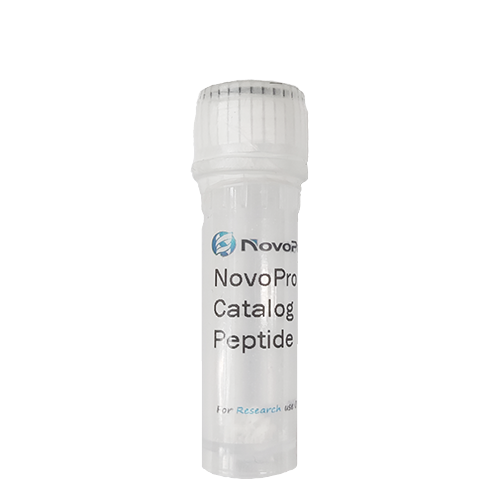Corticotropin-like intermediary peptide
Not For Human Use, Lab Use Only.
Cat.#: 317166
Special Price 205.4 USD
-
Product Name
Corticotropin-like intermediary peptide
-
Documents
Batch to batch variation of the purity
-
Sequence Shortening
PVKVYPNGAEDESAEAFPLEF
-
Sequence
H-Pro-Val-Lys-Val-Tyr-Pro-Asn-Gly-Ala-Glu-Asp-Glu-Ser-Ala-Glu-Ala-Phe-Pro-Leu-Glu-Phe-NH2
-
Length (aa)
21
-
Peptide Purity (HPLC)
96%
-
Molecular Formula
C106H154N24O34
-
Molecular Weight
2308.09
-
Source
Synthetic
-
Form
Powder
-
Description
The source of Corticotropin-like intermediary peptide is Balaenoptera physalus. Corticotropin-like intermediary peptide belongs to POMC. Corticotropin-like intermediary peptide is expressed in ACTH and MSH are produced by the pituitary gland. The peptide has the modification: 13 Ser Phosphoserine (By similarity).
-
Storage Guidelines
Normally, this peptide will be delivered in lyophilized form and should be stored in a freezer at or below -20 °C. For more details, please refer to the manual:Handling and Storage of Synthetic Peptides
-
References
- Pankov Y.A., Nikolaeva O.P., Elisarova G.P.Primary structure of the corticotropin of whalebone whales, finbacks (Balaenoptera physalus). Bioorg. Khim. 2:855-856(1976).
-
About TFA salt
Trifluoroacetic acid (TFA) has a significant impact on peptides due to its role in the peptide synthesis process.
TFA is essential for the protonation of peptides that lack basic amino acids such as Arginine (Arg), Histidine (His), and Lysine (Lys), or ones that have blocked N-termini. As a result, peptides often contain TFA salts in the final product.
TFA residues, when present in custom peptides, can cause unpredictable fluctuations in experimental data. At a nanomolar (nM) level, TFA can influence cell experiments, hindering cell growth at low concentrations (as low as 10 nM) and promoting it at higher doses (0.5–7.0 mM). It can also serve as an allosteric regulator on the GlyR of glycine receptors, thereby increasing receptor activity at lower glycine concentrations.
In an in vivo setting, TFA can trifluoroacetylate amino groups in proteins and phospholipids, inducing potentially unwanted antibody responses. Moreover, TFA can impact structure studies as it affects spectrum absorption.
-
Molar Concentration Calculator
-
Dilution Calculator
-
Percent Concentration Calculator
Mass (g) = Concentration (mol/L) × Volume (L) × Molecular Weight (g/mol)
Peptide Property
- Analysed Sequence:A
- Chemical Formula:A
- Sequence length:A
- Extinction coefficient:A M-1cm-1
- GRAVY:A
- Mw average:A
- Theoretical pI:A
- Data Source:Peptide Property Calculator
GRAVY = grand average of hydropathy
X: Hydrophobic uncharged residues, like F I L M V W A and P
X: Basic residues, like R K H
X: Acidic residues, like D E
X: Polar uncharged residues, like G S T C N Q and Y
Related Products / Services
• Peptide Services: NovoPro's peptide synthesis services include standard chemical peptide synthesis, peptide modification, peptide libraries, and recombinant peptide expression.
• Standard Peptide Synthesis: NovoPro offers quality peptides at the most competitive prices in the industry, starting at $3.20 per amino acid. NovoPro provides PepBox – Automatic Quote Tool for online price calculation.
• Peptide Modifications: NovoPro offers a wide range of peptide modification services including isotope labeling (2H, 15N, and 13C), multiple disulfide bonds, multiple phosphorylations, KLH, BSA, ovalbumin, amidation, acetylation, biotin, FITC, etc.
Please note: All products are "FOR RESEARCH USE ONLY AND ARE NOT INTENDED FOR DIAGNOSTIC OR THERAPEUTIC USE"

